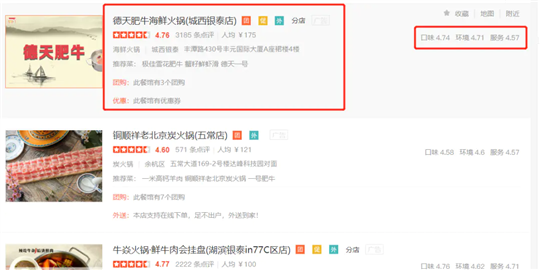爬一波大众点评上美食板块的数据,顺便再把爬到的数据做一波可视化分析

Python版本:3.6.4
相关模块:
scrapy模块;
requests模块;
fontTools模块;
pyecharts模块;
以及一些python自带的模块。
安装python并添加到环境变量,pip安装需要的相关模块即可。
首先,我们新建一个名为大众点评的scrapy项目:
scrapy startproject dazhongdianping
效果如下:

然后去大众点评踩个点吧,这里以杭州为例:
http://www.dianping.com/hangzhou/ch10
显然,我们想爬取的数据如下图红框所示:

在items.py里定义一下这些数据类型:
‘‘‘定义要爬取的数据‘‘‘
class DazhongdianpingItem(scrapy.Item):
# 店名
shopname = scrapy.Field()
# 点评数量
num_comments = scrapy.Field()
# 人均价格
avg_price = scrapy.Field()
# 美食类型
food_type = scrapy.Field()
# 所在商区
business_district_name = scrapy.Field()
# 具体位置
location = scrapy.Field()
# 口味评分
taste_score = scrapy.Field()
# 环境评分
environment_score = scrapy.Field()
# 服务评分
serve_score = scrapy.Field()
然后利用正则表达式来提取网页中我们想要的数据(字体反爬我就不讲了,知乎随便搜一下,就好多相关的文章T_T。只要下载对应的字体文件,然后找到对应的映射关系就ok啦):
# 提取我们想要的数据
all_infos = re.findall(r‘<li class="" >(.*?)<div class="operate J_operate Hide">‘, response.text, re.S|re.M)
for info in all_infos:
item = DazhongdianpingItem()
# --店名
item[‘shopname‘] = re.findall(r‘<h4>(.*?)<\/h4>‘, info, re.S|re.M)[0]
# --点评数量
try:
num_comments = re.findall(r‘LXAnalytics\(\‘moduleClick\‘, \‘shopreview\‘\).*?>(.*?)<\/b>‘, info, re.S|re.M)[0]
num_comments = ‘‘.join(re.findall(r‘>(.*?)<‘, num_comments, re.S|re.M))
for k, v in shopnum_crack_dict.items():
num_comments = num_comments.replace(k, str(v))
item[‘num_comments‘] = num_comments
except:
item[‘num_comments‘] = ‘null‘
# --人均价格
try:
avg_price = re.findall(r‘<b>¥(.*?)<\/b>‘, info, re.S|re.M)[0]
avg_price = ‘‘.join(re.findall(r‘>(.*?)<‘, avg_price, re.S|re.M))
for k, v in shopnum_crack_dict.items():
avg_price = avg_price.replace(k, str(v))
item[‘avg_price‘] = avg_price
except:
item[‘avg_price‘] = ‘null‘
# --美食类型
food_type = re.findall(r‘<a.*?data-click-name="shop_tag_cate_click".*?>(.*?)<\/span>‘, info, re.S|re.M)[0]
food_type = ‘‘.join(re.findall(r‘>(.*?)<‘, food_type, re.S|re.M))
for k, v in tagname_crack_dict.items():
food_type = food_type.replace(k, str(v))
item[‘food_type‘] = food_type
# --所在商区
business_district_name = re.findall(r‘<a.*?data-click-name="shop_tag_region_click".*?>(.*?)<\/span>‘, info, re.S|re.M)[0]
business_district_name = ‘‘.join(re.findall(r‘>(.*?)<‘, business_district_name, re.S|re.M))
for k, v in tagname_crack_dict.items():
business_district_name = business_district_name.replace(k, str(v))
item[‘business_district_name‘] = business_district_name
# --具体位置
location = re.findall(r‘<span class="addr">(.*?)<\/span>‘, info, re.S|re.M)[0]
location = ‘‘.join(re.findall(r‘>(.*?)<‘, location, re.S|re.M))
for k, v in address_crack_dict.items():
location = location.replace(k, str(v))
item[‘location‘] = location
# --口味评分
try:
taste_score = re.findall(r‘口味<b>(.*?)<\/b>‘, info, re.S|re.M)[0]
taste_score = ‘‘.join(re.findall(r‘>(.*?)<‘, taste_score, re.S|re.M))
for k, v in shopnum_crack_dict.items():
taste_score = taste_score.replace(k, str(v))
item[‘taste_score‘] = taste_score
except:
item[‘taste_score‘] = ‘null‘
# --环境评分
try:
environment_score = re.findall(r‘环境<b>(.*?)<\/b>‘, info, re.S|re.M)[0]
environment_score = ‘‘.join(re.findall(r‘>(.*?)<‘, environment_score, re.S|re.M))
for k, v in shopnum_crack_dict.items():
environment_score = environment_score.replace(k, str(v))
item[‘environment_score‘] = environment_score
except:
item[‘environment_score‘] = ‘null‘
# --服务评分
try:
serve_score = re.findall(r‘服务<b>(.*?)<\/b>‘, info, re.S|re.M)[0]
serve_score = ‘‘.join(re.findall(r‘>(.*?)<‘, serve_score, re.S|re.M))
for k, v in shopnum_crack_dict.items():
serve_score = serve_score.replace(k, str(v))
item[‘serve_score‘] = serve_score
except:
item[‘serve_score‘] = ‘null‘
# --yield
yield item
最后在终端运行如下命令就可以爬取我们想要的数据啦:
scrapy crawl dazhongdianping -o infos.json -t json
文章到这里就结束了,感谢你的观看,关注我每天分享Python爬虫实战系列,下篇文章分享中国地震台网爬虫。
为了感谢读者们,我想把我最近收藏的一些编程干货分享给大家,回馈每一个读者,希望能帮到你们。
干货主要有:
① 2000多本Python电子书(主流和经典的书籍应该都有了)
② Python标准库资料(最全中文版)
③ 项目源码(四五十个有趣且经典的练手项目及源码)
④ Python基础入门、爬虫、web开发、大数据分析方面的视频(适合小白学习)
⑤ Python学习路线图(告别不入流的学习)
All done~完整源代码+干货详见个人简介或者私信获取相关文件。。
原文:https://www.cnblogs.com/daimubai/p/14905091.html